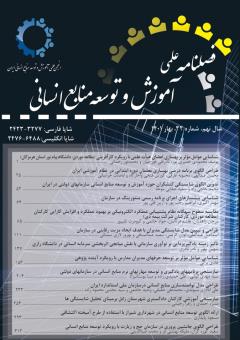ارائه الگوی شایستگی مدیران منابع انسانی مبتنی بر معنویت در محیط کار
محورهای موضوعی :
حسین محمدقاسمی
1
,
سامره شجاعی
2
![]() ,
محمدباقر گرجی
3
,
محمدباقر گرجی
3
1 - دانشگاه آزاد اسلامی واحد علی آباد
2 - دانشگاه ازاد اسلامی واحد علی اباد کتول
3 - دانشگاه آزاد اسلامی واحد علی آباد
کلید واژه: معنویت در محیط کار, ارزش آفرینی منابع انسانی و شایستگیهای معنوی,
چکیده مقاله :
یکی از جنبه های ارزش آفرینی در حوزه منابع انسانی توجه و تمرکز بر شایسته محوری سرمایه انسانی است تا بتوان از آن طریق بر موفقیت سازمان کمک کرد. هدف پژوهش حاضر ارائه الگوی شایستگی مدیران منابع انسانی مبتنی بر معنویت در محیط کار است که در این تحقیق با استفاده از نظرات اساتید دانشگاهی و خبرگان منابع انسانی در شرکت گاز الگویی مطلوب با روش ترکیبی اکتشافی تدوین گردید. و با دو شاخص ضرایب آلفای کرونباخ و پایایی مرکب، پایایی ابزارهای اندازهگیری و با استفاده از شاخص میانگین و واریانس روایی همگرای ابزارهای اندازهگیری و تایید شد.که طبق یافتههای تحقیق هفت عامل شامل عوامل فردی، شایستگیهای معنوی، مهارتهای مدیریتی، مدیریت مشارکتی، ارزش آفرینی منابع انسانی، مدیریت منابع انسانی، پایبندی به قوانین بعنوان ابعاد اصلی مدل شناسایی شدند از هفت عامل شناسایی شده مدل پایبندی به قوانین، مدیریت منابع انسانی و ارزش آفرینی منابع انسانی در سطح اول قرار گرفتند که همانند سنگ زیربنای مدل عمل می کنند که معنویت در محیط کار باید از این متغیرها شروع و به سایر متغیرها سرایت کند. این سه عاملها دارای ارتباط متقابل با یکدیگر هستند. برای تدوین مدل از نرم افزار AMOS استفاده شده است.
1. Abbaspour, A, Advanced Human Resource Management, Samat Publications, Tehran: Samat, 2009,)in Persian(.
2. Azar A, Khosravani F, Jalli R, Research in Soft Operations, Industrial Management Organization Publications, Tehran, 2013)in Persian(.
3. Cavanagh, G.F. Spirituality for managers: context and critique, Journal of Organizational Change Management,1999; 12(3): 86-199.
4. Chao, Yu-Pin; Ying-Chyi Chou; & Wen-Hsiang Lai . AHP Competency Model in the Service Chain Industry. Advances in Management & Applied Economics, 2017; 7(3): 1-20.
5. Dubois, D.Q, Rothwell, W.J., King Stern, D.J & Kemp, L.K. “Competency – based human resource management”, Davies-Black Publishing,(2004).
6. Giberson, T. R. "Performance Capabilities and Competencies at the Undergraduate and Graduate Levels for Performance Improvement Professionals", Wiley InterScience, 2010; 22(4): 99-120.
7. Haj Karimi, A, Rezaian, A, Hadizadeh, A, Bonyadi Naeini, A, Modeling the competencies of human resource managers in the public sector in Iran. Public Management Perspectives,2011; 8: 43-23.)in Persian(.
8. Hosseini, S, “Competency System in the National Iranian Gas Company with Emphasis on Attracting the Competent and Educating the Efficient.” First Conference on the Development of Meritocracy, 2008.)in Persian(.
9. Islamian, M, Gholipour, R, Hemtian, H, Designing and explaining the competency model of senior managers of state-owned banks with emphasis on the general policies of the resistance economy, Journal of Executive Management, 2018;19(10):71-80.)in Persian(.
10. Karakas, F. Spirituality and Performance in Organizations: A Literature Review, Journal of Business Ethics, 2010; 94: 89-106.
11. Karaman‐Kepenekçi & Ahmet Aypay.Teachers’perceptions of tolerance in teacher–administrator relationships in Turkey, International Journal of Leadership in Karen, C. C., George, R. G., & Sally, A. R. (2000), A Framework for Accommodating Religion and Spirituality in the Workplace (and Executive Commentary). The Academy of Management Executive, 2009;14(3):124-2009.
12. Khomeini,R, Sahifa Imam, Tehran, Imam Khomeini Publishing House. 1999; 16,)in Persian(.
13. Masoumi, H, Explaining the Concept of Spirituality in the Leadership of the Organization from the Perspective of Western and Islamic Approach, Journal of Nations Research, 2016; 9: 104.,)in Persian(.
14. Mitroff, I., & Denton, E. A spiritual audit of corporate America: A hard look at spirituality, religion, and values in the workplace (1st ed.). San Francisco: Jossey-Bass Publishers, 1999.
15. Myers, J. E. Wellness Throughout the Lifespan, Guidepost, May,1999.
16. Nasehi Far, S, Masoomzadeh Z, A,"A model for evaluating the competencies and competencies of the managers of the Ministry of Commerce", Business Reviews, Year,2010; 8(41), )in Persian(.
17. Nitin V. Competencies and Competency Model-A Briefoverview of its Development and Application, SIES Journal of Management, April - August,2010; 7(1): 121-131.
18. Pourabedi, M , Zarabi, V, Sajjadi Naeini, H, Razi, Z, Designing a Multidimensional Competency Model for Managers and Employees, Quarterly Journal of Human Resource Management Research, 2016; 8(2).)in Persian(.
19. Quinn, J. B., & Hilmer, F. G. Strategic outsourcing. Sloan management review ,1994; 35(4): 43-55.
20. Skorková, Zuzana . Competency models in public sector”. Procedia- Social and Behavioral Sciences, 2016; 230: 226-234.
21. Tasdighi, M, Barriers to the development of meritocracy in religious thought and how to use the sources of power among competent and incompetent managers, Proceedings of the first conference on the development of meritocracy in organizations, Tehran, 2006)in Persian(.
22. Tomaj, Y. Developing a Process Model for the Competencies of Public Sector Managers in the Public Sector with Emphasis on General Policies of the Administrative System, PhD Thesis, University of Tehran, 2012)in Persian(.


